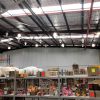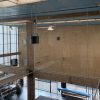
Airius Air Pears and Cooling in Sports Halls – Barriers to a Sale Put Forward by a Mechanical Engineer.
Airius Oceania recently had an engineer respond to their cooling proposal for an Australian client with these comments, in red italics below.
The client was very keen to purchase our units but the engineer’s comments dissuaded the client and they never proceeded with what was a smart and cost-effective solution.
As the engineer’s comments are generally incorrect or inaccurate, we thought that despite the assorted installations, case studies and testimonials we have in Australia espousing the value of Airius Air Pears for cooling in large spaces such as sports halls, (which this proposal was for) we should ‘right the wrongs’ here and reiterate and clarify the value, efficacy and success of Airius Air Pear’s performance in summer cooling applications.
-
‘The Air Pear fans proposed operate as a destratification fan (to send the hot air at the top of the gym down to ground level so that the whole gym comes to a constant temperature).’ Engineer
Airius Air Pears work just like a large bladed fan. Without the large exposed blades. In this cooling for sports hall application, they move air from the roof to floor. They simply do it using much smaller units without large exposed blades. They could also move air horizontally from wall to wall if required. Yet destratification is only part of the story.
There are many applications worldwide where large bladed fans have been used for cooling. It’s probably their largest market.
And its the same for Airius Air Pear air turbines.
If you look at the attached chart of air movement supplied by a large bladed fan manufacturer (at the end of this blog) you can see that the air flow direction and footprint is doing exactly as an Airius Air Pear does.
It is moving warm air from the roof to the floor and then circulating it back up again. Destratification is only part of their story too.
Yet these large fans are used worldwide for cooling.
WHY?
Because air movement, even at high temperatures, offers cooling via evaporation. Air movement at 35 or 40 Deg. C. is better than no air movement. Far, far better. That’s why fans are used worldwide in very hot countries, to offer cooling.
It is important to note there is very little difference in performance between a large bladed fan and an Air Pear when it comes to cooling air circulation. The Air Pears do the same job without exposed large blades and simply require more, but less costly units to achieve the same outcome.
‘They are typically used in large warehouses to help reduce energy costs by reducing heat loss from the roof surface.’ Engineer
This statement is really incorrect in both assumptions and needs to be clarified.
Airius Air Pears cooling the Green Point Christian College Sports Hall in NSW and YMCA Caloundra, QLD
Considering the largest market for Airius Air Pears worldwide is in Supermarkets, and the units are also used extensively in sports halls, indoor pools, museums, offices, libraries, classrooms, theatres, hospitals, aged care facilities and warehouses, the typical use suggested here is incorrect.
In Australia, there are warehouses using the Airius units and they are all being used for cooling . For example, the Haliburton warehouse in Moomba, SA, where the temperature regularly reaches 48-50 Degrees C, and customers such as DHL, Lush Cosmetics and Tyco who use them in hot western Sydney to cool the workers in their warehouses.
Secondly, and more importantly, the use of Airius Air Pears as destratification fans in winter (Large bladed fans are also used in winter to destratify spaces, just not as effectively as Airius Air Pears) is primarily to reduce heating costs by pushing all the lighter warmer air back down to the floor. This is where the largest heating energy savings are achieved. There is a reduction in heat loss through the roof because the Delta Tin/ Tout is significantly reduced with the use of destratifications fans, resulting in a lower rate of heat loss, but it’s not the prime energy saving opportunity.

This CFD graphic highlights the destratification outcomes in a building from using Airius Air Pears
The prime energy savings opportunity using Airius Fans in winter in a heated building environment, is in the relocating of the warm air in the space back to the floor where it is needed. This stops the over delivery of warm air. Without Airius Air Pears running in a heated space, a client will be wasting large amounts of heated energy by overdelivering warm air to the space to compensate for all the heat rising up and sitting under the roof or ceiling. Energy savings of 20-50% are usually achievable (worldwide) resulting in very low ROI’s if Airius Air Pears are used to destratify a space in winter in a heated building.
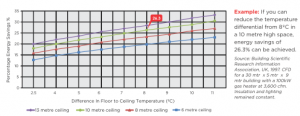
This chart above from BSRIA UK details the heating energy savings achievable by using Airius Air Pears to destratify in a stratified heated environment.
‘They provide no direct heating or cooling and recirculate the air already in the gym only (i.e. provide no fresh air)’. Engineer
Well this is sort of correct. But its out of context, is not explained to the client and is missing clarifications about the actual outcomes. If you ignore the significant value of air movement from cooling even in tropical environments then, yes, it is correct, because the Airius Air Pears, and the alternative large bladed fans, or other fan types, are not air-conditioning units and never profess to be.
The recirculation comment is correct but is that a bad thing? Fans of all types have been doing that for many many years. Alternatively, if you want, Airius can also bring large amounts of air into or out of the building without the use of expensive ductwork.
However, air movement has been used for cooling people for thousands of years in the warmest and most humid environments. (Egyptians, Sumerians etc.) There is also a large amount of empirical scientific research around thermal comfort and the value of air movement for cooling in very warm environments and this research highlights the cooling value of air movement at temperature’s up to and beyond 36 Degrees C. (Airius has another great blog on our web site about the value of air movement and cooling)

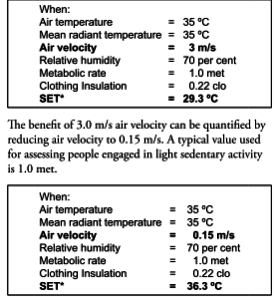
These charts above are some of many scientific research documents that highlight the value of air movement for cooling in temperate, sub-tropical and tropical climates.
-
‘We do not consider they will provide any noticeable air movement at ground level and there are no air movement figures provided with this submission.’ Engineer
In this case, this statement is incorrect too. There are numerous case studies and testimonials of the Airius Air Pears here in Australia being used for cooling in high activity spaces such has sports halls in hot and humid locations such as Townsville, Rockhampton and the Gold Coast. To create that cooling, they need significant air flow at floor level.
Air movement at floor level is part of Airius’ calculations and design and Airius can provide so much air movement at floor level, if required, they could almost blow people over! This is why Airius has a large range of products and speed controllers, designed to suit every application.
Now, if this was such a concern and the engineer was undertaking due diligence (which in essence he was) why didn’t the engineer request the air flow data? The volume of air discharged from the proposed units was supplied to the client plus links to the Airius web site smoke tests which highlighted, very clearly, the type of air flow volumes you would achieve 8-9 metres above floor level using the Airius Model 60 PS4, for example.
This text below is part of a 2015 testimonial from the Facility Manager at the prestigious Sydney private girls school, SCEGGS, located at Darlinghurst in inner Sydney, contradicting the engineer’s air flow statements above.
This testimonial and much more supporting data was supplied to the client for this project and is available on the Airius website.
‘….The space is a lot more usable in the hotter summer months. We have received great feedback from both the school PE department and also external hirers.
High intensity sport is played in the gym now with a lot more comfort. We have the ability to set the fans on five settings ranging from 20%, 40%, 60%, 80% or 100% capacity. It is rare we turn the fans to 100% even though they are 8.5 meters off the playing surface. To put it into context the gymnastic training group can only have the fans on a setting of 3 out of 5 (60%) because it affects the throwing of the ribbon in the air.’
| Keith Stevenson
Facilities Manager p 02 9332 1133 | m 0477371651 SCEGGS Darlinghurst | 215 Forbes Street Darlinghurst NSW 2010 |
If requested, Airius can supply the required air flow data.
-
‘In winter, they may help maintain a slightly higher gym temperature by sending warm air from higher in the gym back down to ground level (where the people are). In summer, they will have an adverse effect and may make the gym warmer at ground level.’ Engineer
This statement above is almost 100% incorrect.
In winter, if you have no heating in your hall there will still be a stratification level where the warmer air in the space sits up at the roof and the Airius units will make the space more comfortable as the engineer notes. If warmth is available the Airius units will bring it down to the floor.
However, the engineer’s comments around having an adverse effect on thermal comfort in summer are ill conceived and are not offering his client an objective and complete picture as he is ignoring the proven value of air movement for cooling at higher temperatures, while also dismissing the evidence (testimonials) provided by similar building users in warm Australian climates and the reams of scientific and engineering research around the value of air movement for cooling.
Overall, when using Airius Air Pears there is significantly improved thermal comfort in summer in all Australian conditions. If the correct units are selected, extremely large volumes of cooling air movement can be created at floor level if needed. No, it’s not air conditioning, but also it doesn’t cost anywhere near what air conditioning costs to buy, install and run.
Warm air movement in summer is much more comfortable than no air movement in summer.
When considering an Airius Air Pear it’s important to investigate the supplied case studies, testimonials from others in a similar application and the empirical scientific research around air movement and improvements in thermal comfort in warm and humid or hot and dry climates to provide you with a balanced and real world assessment.
Just because an engineer said so doesn’t mean it’s correct!
We have many well known engineering consultancies here in Australia such as Arups, Aecom, JHA, Wood and Grieves, BCA, STP, etc. recommending Airius Air Pears for a range of cooling applications in all sorts of Australian climates.
Airius can help you understand all of these outcomes, the benefits of using Air Pears over alternatives and how to apply them successfully to your facility as required.
Just call Airius on +61 0401 848 888 or email us at [email protected].
John Brodie
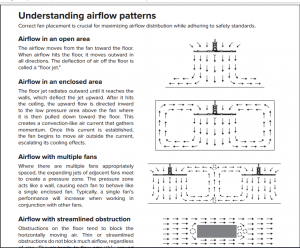
Air flow pattern of a large bladed fan.
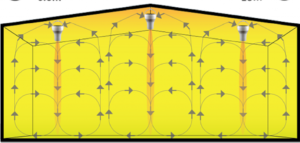
This image above of Airius Air Pear units in operation highlights how the air flow pattern is similar to that of a HVLS product. It’s just that one uses large exposed blades and one doesn’t. Eventually the Air Pear’s air flow pattern will start to rise back up to the roof again and continue recirculating as does the HVLS fan air flow pattern.
Similar Outcome -Different Technology.





